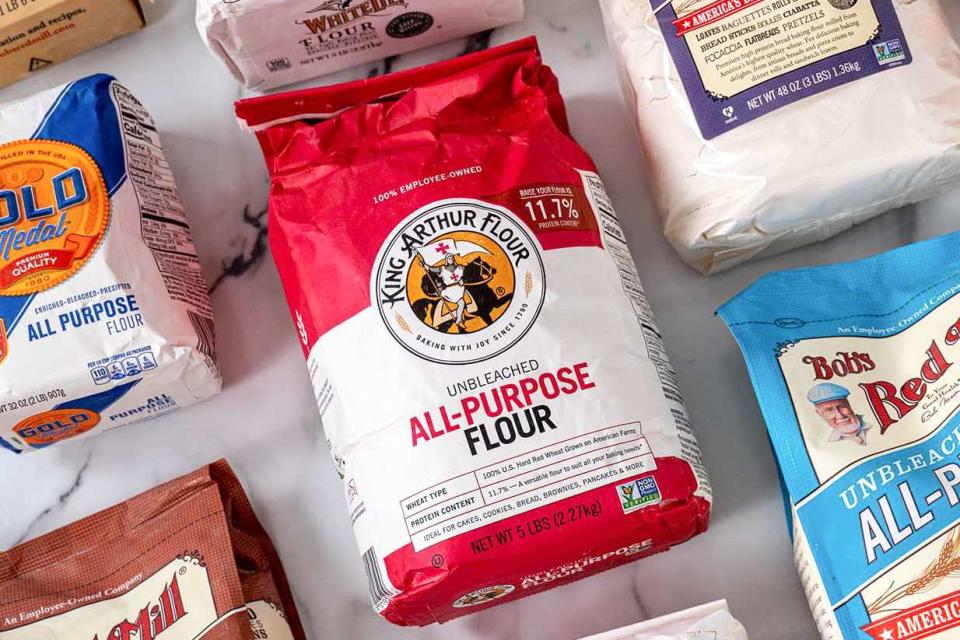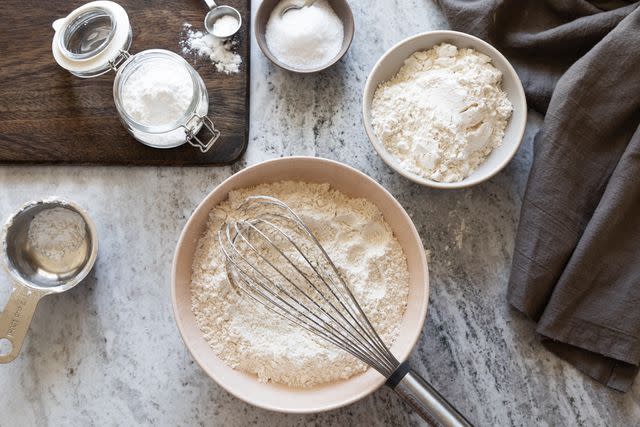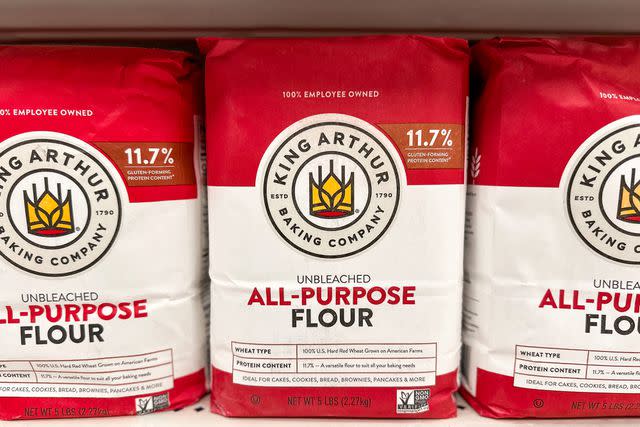The Only Way You Should Store Flour, According To King Arthur Baking Company
Yes, there's a right way and I asked the experts.

Simply Recipes / Andy Christensen
You are about to whip up a batch of cookies or muffins, or a birthday cake, only to discover that your flour smells or looks a little funky—or, worse, has some creepy crawlies in it. There are a few things you can do.
First, toss that funky flour in the trash or compost bin. Second, either dash to the supermarket for new flour or pre-made goodies or make up an excuse for why there will be no cake on this birthday. Third, learn how to keep your flour from ever going bad again.
For help on the last option—ensuring that your flour stays fresh as long as possible—I reached out to the experts at King Arthur Baking Company. They sell more than two dozen types of flour, among other baking essentials, so they know a thing or two about how to keep your flour in tip-top shape, including the right kind of container to keep it in, where to store it, and how the type of flour affects optimal storage conditions and shelf life. Read on and never have another flour-spoilage snafu.
What’s the Best Container for Storing Flour?
All types of flour—including all-purpose, whole grain, gluten-free, and even nut flours—should be stored in an airtight container, says Frank Tegethoff, a research and development specialist at King Arthur. As long as the container is airtight, any material is fine, including plastic, glass, metal, and silicone. The key is to keep out moisture, heat, and odors.
If you choose to use plastic bags for your flour, be sure to use a zip-top bag that's meant for freezer use, Tegethoff says and adds, "Twist-tie closures are a no-no."
Regardless of what kind of container you use, be sure to label the container with the type of flour, the date you opened it, and the best-by date on the original package. Or you can simply slip the flour in its original bag inside the container.

Simply Recipes / Lori Rice
Pantry, Fridge, or Freezer? The Best Place To Store Your Flour
Once the flour is in an airtight container, you have a few options for where to store it. All-purpose flour and other refined flours can be stored for short periods in a cool, dry, dark place, such as a pantry. Whole grain flour and nut flour should be stored in the freezer because they contain oils that can cause the flour to go rancid quickly.
If you don't use your all-purpose and refined flours very often, your best bet is to store them in the freezer as well. If you don't have room in your freezer, you can store flour in an airtight container in the fridge, but the freezer will help it to last the longest.
Understanding the Best-by Date on Your Flour
Most brands of flour, including King Arthur, include a "best-by" date, sometimes also noted as "best if used by" or "best if used before." This date indicates when the manufacturer recommends using the product by for the best quality but it is not an indicator of safety. Flours can be perfectly safe to use past the "best by" date, especially when properly stored in the pantry or the freezer.
Refined flour, such as white, all-purpose, high-gluten flour, or white rye is fine to use if it looks and smells like it did when you first opened the package.
On the other hand, because their higher fat content can cause them to go rancid, whole grain flours, such as whole wheat, pumpernickel, and buckwheat, should be discarded if they are past their best-by date, according to King Arthur. The same goes for nut flours. Also, note that self-rising flours may have lost their ability to raise your baked goods once they're past their best-by date.

Simply Recipes / Wanda Abraham
How Long Does Flour Last?
Different types of flours have different shelf lives, and this will be reflected in the best-by date on the package. That said, white flour should last about a year when properly stored in the pantry, while whole wheat flour should last three to six months in the pantry, according to the USDA's FoodKeeper App. Nut flours tend to have a fairly short shelf life, but you can extend that life by storing them in the freezer.
How To Tell if Your Flour Has Gone Bad
"If there is any sign of infestation or an off aroma the flour is not usable," says Tegethoff. And that's true even if the flour hasn't reached its best-by date.
According to King Arthur, flour that's gone bad might smell like Play-Doh—that might have been a selling point for me when I was a kid, but as an adult, I know it's not a good thing. Other signs that it's time to toss any type of flour and start with a fresh bag include a yellow or gray color (or any color other than its original color), any signs of mold, and sour, musty, or any other bad smells.
The Takeaway
Store all types of flour in an airtight container in either the pantry or the freezer, depending on the type of flour. Oily flours, such as whole wheat and nut flours, should be stored in the freezer, and you can also extend the shelf life of all-purpose and other types of white flour by storing them in the freezer.
If your flour develops a bad smell or changes in appearance, it's time to toss it and move on to a new bag. And remember, as King Arthur notes, your best defense against your flour going bad is to use it up quickly in all your favorite baking projects.
Read the original article on Simply Recipes.

